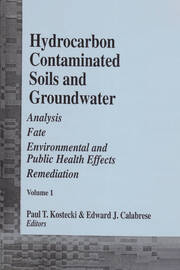1st Edition
Hydrocarbon Contaminated Soils and Groundwater Analysis, Fate, Environmental & Public Health Effects, & Remediation, Volume I
Proceedings of the February 19-22, 1990, conference held at Newport Beach, California. Conference
Directors: PAUL T. KOSTECKI, EDWARD J. CALABRESE, and CHARLES E. BELL.
Advisory Committee: RICHARD BOZEK, EEI; TERRY BRAZEL, SWRCB; MARK COUSINEAU, AG; SETH DAUGHERTY, Orange County; RALPH De La PARRA, SCE; JERRY HAGGY, Shell; JOHN HANBY, HAL; JOHN HILL, ICF; JOHN HILLS, City of Anaheim; DOROTHY KEECH, Chevron; BILL KUCHARSKI, WC; DAVID LEU, Mittel Hauser; MARY McLEARN, EPRI; PHIL OLWIN, Texaco; DENNIS PAUSTENBACH, MC; ART POPE, ARCO; LYNNE PRESLO, Weston; DON ROTHENBAUM, KA; KIM SAVAGE, EPA/OUST; CARL SHUBERT, IT; WENDELL SUYAMA, Lockheed; MICHAEL WANG, WSPA; JOHN WILLIAMS, TT; and WILLIAM WINTERS, AEM.
Biography
PAUL T. KOSTECKI (University of Massachusetts), EDWARD J. CALABRESE



